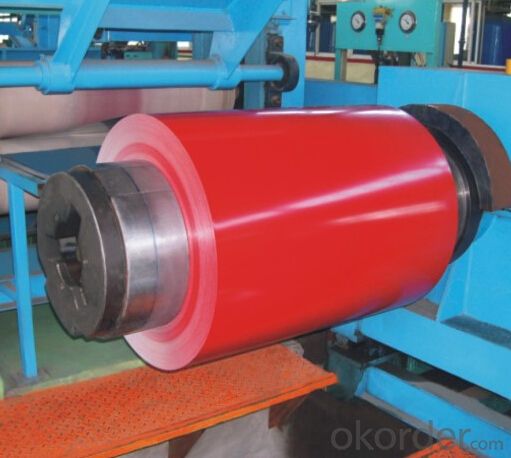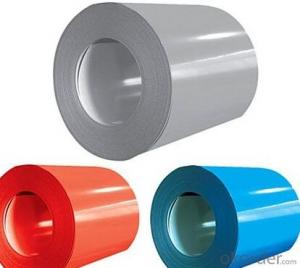Prepainted Galvanized Steel Coil Z275 PPGI Galvanized Steel in Coils
- Loading Port:
- China main port
- Payment Terms:
- TT OR LC
- Min Order Qty:
- 10 m.t.
- Supply Capability:
- 10000 m.t./month
OKorder Service Pledge
OKorder Financial Service
You Might Also Like
1.Bried Introduction:
1).Colr steel is coated with organic layer, which provides higher anti-corrosion property and longer lifespan than that of galvanized steel sheets.
2).The base metals for color steel consist of cold rooled. HDG lectro-galvanized and hot-dip alu-zinc coated steel. The finish coats for color tels can be classified into groups as follows: polyester, silicon modiied polyesters, polyvinylidene fluoride, high-durability polyester, etc.
3).The production process has evolved from one-coating-and-oe-baking to double-coating-and-double-baking, and even three-coatig-and-three-baking.
4).The color of the color steel has a very wide selection, like orange, creamcolored, dark sky blue, sea blue, bright red, ivory white, procelain blue, etc.
5).The color teels can also be classified into groups by their surface textures, namely regular prepainted sheets, embossed sheets and printed sheets.
2. Steel coil, prepainted steel coil,prepainted galvanized steel coil Advantages:
(1).High strength, Good corrosion
(2).Well rainproof performance
(3). Easy to install and remove
(4).Competitive price with best quality
3.Image of prepainted steel coil:

4.Data of prepainted steel coil:
Thickness | 0.14mm-1.2mm |
Width | 600mm-1250mm |
Single weight | Max 6.0MT |
Zinc thickness | 30-275g/m2 |
Steel gardes | TDC51D2,TDC51D+AZ,TDC51D, GR.A, GR. B, SPCC, SPHC, DX51D, ect. |
Standard | JIS G3302, JIS G3313, ASTM A653, GB/T2518-88, GB11253-89,, BS, ect. |
Packing | Wrapped by plastic film and waterproof paper, and then fastened on wooden pallet.Or as you request. |
Used | Used in building material, roof, profile,pipe making, furniture making, etc. |
Minimum quantity | Can be 25MT |
Price | FOB Tianjin Port or Qingdao Port 600-950USD/MT |
Delivery time | within 25 days after receiving 30% deposit or copy of LC at sight |
Payment terms | T/T or L/C |
Supply ability | 10,000 MT per month |
5.FAQ
We have organized several common questions for our clients,may help you sincerely:
①How about your Warranty?
Warranty: 1-Year for the whole light. Warranty is based on correct storage, installation, using and maintenanc
②How to guarantee the quality of the products?
We have established the international advanced quality management system,every link from raw material to final product we have strict quality test;We resolutely put an end to unqualified products flowing into the market. At the same time, we will provide necessary follow-up service assurance.
③How long can we receive the product after purchase?
In the purchase of product within three working days, We will arrange the factory delivery as soon as possible. The pecific time of receiving is related to the state and position of customers.Commonly 7 to 10 working days can be served.
- Q:How are steel coils used in the manufacturing of power generation equipment?
- Steel coils are used in the manufacturing of power generation equipment as they are essential for fabricating components like turbine blades, generator frames, and structural supports. These coils are shaped, cut, and molded into various parts, ensuring strength, durability, and stability in power generation equipment.
- Q:Can steel coils be stacked on top of each other?
- Yes, steel coils can be stacked on top of each other.
- Q:I have a belly button piercing and the metal is stainless steel.. I was wondering does it develop rust whenever you go shower and clean it? Can I still swim in the summer with it or do I have to take it out? What happens if I swim in the pool with it?
- No it won't rust. Just make sure to get the pool water out of the piercing when done at the pool. Just to avoid drying out the skin too much.
- Q:I am thinking of buying a stainless steel necklace, but I need to know if it will discolor. My brothers ring turned brown, but he forgot what kind of metal it was. Also answer if I can wear it in the shower because I wear my other necklace in it.
- I would say don't wear it in the shower because it will tarnish and it could rust.
- Q:As we all know Shaq killed the movie Steel by suckin so bad but does anyone know what happened to the comic book version.
- The comic book has been long cancelled. You can see Steel in the ongoing 52 miniseries.
- Q:What are the common processing defects in steel coils?
- Steel manufacturers must identify and rectify the following processing defects commonly found in steel coils: 1. Coil breaks: These occur when the steel strip breaks during the process of winding the coil. Improper tension control or material defects can cause these breaks. 2. Slivers: Thin, elongated steel pieces get trapped in the coil during the rolling process. Foreign materials, scale, or defects in the rolling mill can cause slivers. 3. Edge cracks: Cracks appearing along the edges of the coil are known as edge cracks. Improper edge trimming, material defects, or excessive rolling forces can cause these cracks. 4. Surface defects: Scratches, pits, or scars on the steel coil constitute surface defects. Handling issues, improper cleaning, or rolling mill defects can cause such defects. 5. Coil set: Coil set refers to the coil's tendency to retain a curvature even after it has been uncoiled. This can occur due to uneven cooling during the rolling process or improper tension control. 6. Oil spots: Stains or discolorations on the steel coil caused by residual oil or lubricants are known as oil spots. Inadequate cleaning or incorrect lubricant application can lead to oil spots. 7. Wavy edges: Irregularities or waves along the edges of the steel coil are referred to as wavy edges. Uneven rolling forces or improper edge trimming can cause these irregularities. 8. Lamination: Lamination defects occur when layers or sheets of steel are not properly bonded together. Material defects or improper rolling conditions can cause lamination defects. 9. Burr: A raised edge or roughness along the edge of the steel coil is called a burr. Improper trimming or cutting processes can cause burrs. 10. Non-uniform thickness: Non-uniform thickness refers to variations in the thickness of the steel coil. Uneven rolling forces, improper cooling, or material defects can cause non-uniform thickness. Identifying and addressing these processing defects is crucial for steel manufacturers to ensure the quality and reliability of their steel coils.
- Q:What materials are used to make steel coils?
- Steel coils consist primarily of steel, an alloy primarily composed of iron and carbon. The choice of steel type for coil production depends on the desired properties and applications. Carbon steel is typically the preferred option due to its strength, durability, and versatility. Additional alloying elements, like manganese, silicon, nickel, or chromium, may be incorporated to enhance specific steel characteristics or properties. To produce steel coils, the raw materials are melted, the molten steel is refined, and specialized equipment and processes are employed to shape it into coils.
- Q:How are steel coils used in the petrochemical industry?
- Steel coils are commonly used in the petrochemical industry for various purposes such as manufacturing storage tanks, pipes, and equipment used in the refining and processing of petroleum and petrochemicals. The coils are often formed into specific shapes and sizes to meet the requirements of different applications, ensuring durability, strength, and resistance to corrosion and high temperatures in the harsh environments found in petrochemical plants.
- Q:What are the different methods of edge wave correction for steel coils?
- There are several methods of edge wave correction for steel coils. One common method is using edge trimmers, which cut off the uneven edges of the coil to create a straighter edge. Another method is through tension leveling, where the coil is stretched to remove the wave-like deformities. Additionally, some manufacturers use roller leveling, where the coil passes through a series of rollers that press and flatten the edges. Lastly, laser technology can be employed to accurately measure and correct any edge wave deformities.
- Q:What are the common welding methods used for steel coils?
- The common welding methods used for steel coils include shielded metal arc welding (SMAW), gas metal arc welding (GMAW), flux-cored arc welding (FCAW), and submerged arc welding (SAW).
1. Manufacturer Overview |
|
|---|---|
| Location | |
| Year Established | |
| Annual Output Value | |
| Main Markets | |
| Company Certifications | |
2. Manufacturer Certificates |
|
|---|---|
| a) Certification Name | |
| Range | |
| Reference | |
| Validity Period | |
3. Manufacturer Capability |
|
|---|---|
| a)Trade Capacity | |
| Nearest Port | |
| Export Percentage | |
| No.of Employees in Trade Department | |
| Language Spoken: | |
| b)Factory Information | |
| Factory Size: | |
| No. of Production Lines | |
| Contract Manufacturing | |
| Product Price Range | |
Send your message to us
Prepainted Galvanized Steel Coil Z275 PPGI Galvanized Steel in Coils
- Loading Port:
- China main port
- Payment Terms:
- TT OR LC
- Min Order Qty:
- 10 m.t.
- Supply Capability:
- 10000 m.t./month
OKorder Service Pledge
OKorder Financial Service
Similar products
New products
Hot products
Related keywords



























